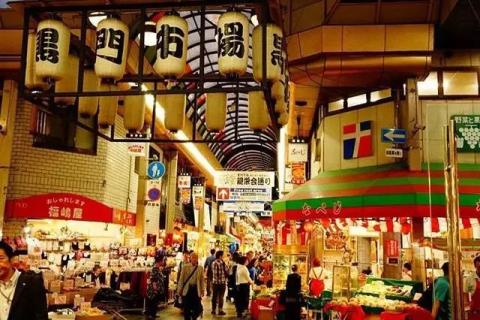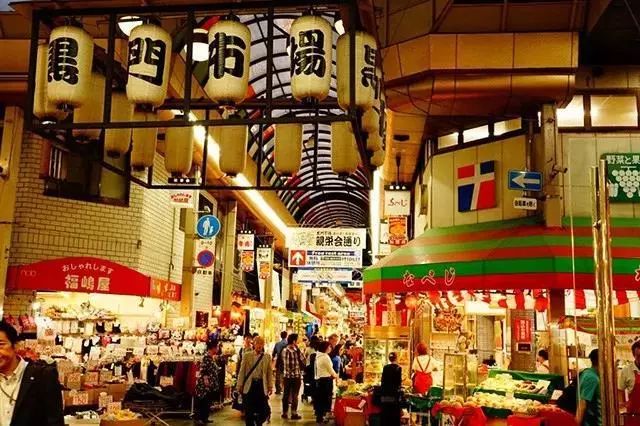
The market has always been the most intuitive epitome of a local food culture.

It can be a museum.
You can learn about the city's geography, climate characteristics and local people's eating habits from the ingredients.

It can also be a large shopping street.
There are not only farmers and seafood markets, but also restaurants, flower shops, clothing stores, drugstores and other shops. It is a street that meets people's basic needs for daily necessities.

When it comes to markets in Japan, everyone always thinks of Tsukiji Market in Tokyo, a lively Tokyo landmark that combines tuna auctions and numerous gourmet restaurants.

In fact, there are many markets in Japan that are very charming and worth visiting!
01
Tokyo Tsukiji Market
Tsukiji Market is one of the top ten seafood and fish markets in the world. It is known as the "Tokyo Kitchen" and is very popular among Japanese residents and foreign tourists.


This Tokyo Tsukiji Market, known as "the kitchen and stomach of all Japanese", not only brings super satisfying enjoyment to your taste buds, but also allows you to experience Japan's urban life up close and experience its folk customs.


Although the on-site market has been moved to Toyosu Market in Odaiba, the off-site market still remains.
Even without the busiest fish market, many diners still have an inseparable feeling of Tsukiji in their hearts.

There are many famous sushi restaurants and seafood restaurants outside the market. Whether you prepare a food guide in advance or eat on the go, you will not be disappointed here.

Not only is Japan's first Yoshinoya here, but there are also many old shops with ancient flavors. Those that have not left the old shops make Tsukiji still a delicious and fun place today.

At the same time, Toyosu Market also retains the classic program of Tsukiji Market - the tuna auction. Customers can watch the auction process through the glass windows in the corridor.


Different from the old-fashioned Tsukiji Market, Toyosu Market is a more professional modern fish market structure, with various shops scattered throughout the market building.
Although it lacks the lively atmosphere of the old market, it is cleaner and more comfortable.


Big sushi
Sushi Dai, a famous sushi restaurant in Tsukiji Market, has been praised as a god-level store. There is always a long queue when visiting Tsukiji Market.

Edomae sushi is served here. If you have the opportunity to sit in the restaurant, feel free to order the chef's recommended set meal, which is delicious enough.

Stores in Toyosu Market still have to wait in line, but compared to the exaggerated queues in Tsukiji, the flow of people is much smaller, and delicious food is no longer hard to find.

bird vine
The famous store Bird Teng also moved to Fengzhou Market.
The store specializes in chicken dishes. The most basic parent-child donburi and fried chicken nuggets are both famous and unstoppably delicious. There is also a chicken butt rice bowl, which has a good reputation among diners.

The new store is more spacious and clean than the narrow stores in the past, and there is almost no need to queue.

Yachiyo
Yachiyo is a popular tonkatsu restaurant in the original Tsukiji Market.
Although it specializes in fried pork cutlets, the store's fried fish cutlets are also well received.

After all, it’s first-come-first-serve in a building close to the water, so you can easily buy the freshest seafood in the seafood market.
The price of 1,500~2,000 yen is also much more affordable than other seafood restaurants.

02
Osaka Kuromon Market
Kuromon Market is known as the "Kitchen of Osaka".
Rather than saying it is a vegetable market, it is better to say it is a small commercial pedestrian street.

This is the largest seafood market in Kansai, spanning 5 blocks and gathering more than 170 shops.
It looks like an ordinary traditional market, but it is crowded with people and full of colorful billboards and dazzling shelves.

Not only seafood, but also grilled fruit stalls, grilled pineapple, peaches, cantaloupe, grilled watermelon will completely subvert your imagination!
Even cosmeceuticals are cheaper than Shinsaibashi.

Here, you can buy the freshest seafood, the best Wagyu beef, cooking ingredients from all over the world, and a lot of snacks to eat along the way.

Squid eggs, grilled salted ayu, horse dung sea urchin, Ishibashi oden, grilled squid, grilled scallops, tempura, takoyaki...

There is still freshly grilled wagyu beef, which is dipped in sauce and leaves a fragrant aroma on your lips and teeth. If you are too tired of eating seafood and beef, you can drink a glass of juice as an intermission.

If you want to get more depth, you can first challenge the "Three Musketeers of Kuromon Market":
Tuna, called "tuna" by the Japanese, is a swordsman, and the black tuna three-color donburi is a must-try;

Xichuan Fresh Fish Restaurant is the second swordsman, with oysters and sea urchins cooked to order;
Freshly squeezed light snow strawberry juice is the Three Musketeers, it is the best to remove fishy smell and relieve greasiness.

The most popular food at Kuromon Market is pufferfish.
Fugu is poisonous, but there is no need to worry in Kuromon Market. Only chefs with special licenses can cook fugu.

Eat pufferfish at the famous restaurant Hamato Roku. There are six ways to eat pufferfish, sashimi, hot pot, and deep-fried. One pufferfish can taste in a variety of ways.
For tourists, this is simply a paradise for shopping and eating.

03
Kyoto Nishiki Market
Walking around the streets of Kyoto, you may encounter ancient landmarks with hundreds or even thousands of years of history every few steps.
However, these "cultural heritage" are not limited to temples, shrines or palace courtyards. A restaurant or a clothing store may be a century-old store.


In the heart of Kyoto, there is the Nishiki Market with a long history of 400 years.
Nishiki Market is about 400 meters long and has 130 shops.


At Nishiki Market, you can not only eat seafood snacks such as squid eggs, sea urchins, and scallops, but also unique Kyoto-style delicacies.

Kyoto pickles to go with rice, various Japanese sweets, authentic matcha warabi mochi, the best red bean "Tamba Danagon"...
When in Kyoto, don’t just focus on seafood.


If you come to Nishiki Market during the cherry blossom season, you can also buy a variety of cherry blossom-limited foods, including soft and delicious cherry blossom cakes, cool and refreshing cherry blossom wine, floral-flavored cherry blossom candy, and even pink cherry blossom salt.


The main road of Jin Market is only 3 meters wide, so it is not convenient to walk all the way to eat.
If you want to "make skewers" in an elegant way, you can take the snacks you bought and go to Kyomachiya Nishikijo next to the market.

In this store, you only need to order another dish, and the owner will help you put various takeaway foods into plates, turning snacks into feasts.

In the eyes of Matcha lovers, Kyoto ≈ Matcha.
The SNOOPY Tea House in Nishiki Market may be the cutest matcha shop in Japan.
The matcha latte with floating Snoopy marshmallows is a regular drink of the tea house. Looking at the white puppy, I really can’t stop eating it.

04
Hokkaido Hakodate Morning Market
In the artsy Hokkaido, there are also wet markets where you can enjoy a good meal.
Hakodate Morning Market is located next to JR Hakodate Station, and the transportation is very convenient.

Every morning, more than 200 shops of various sizes and more than 400 aquatic product stores open together.

My eyes are filled with fresh seafood, my nose is filled with the salty smell of seafood, and my ears are filled with the cries of vendors.

When you come to Hakodate to go to the market, eating only sashimi will make you look unskilled.
The "three famous crabs" king crab, hairy crab and matsuba crab can be eaten boiled or grilled.


Fresh sea urchins are cut in half and eaten raw with mustard and soy sauce, without wasting any umami flavor; live squid is freshly caught and cooked, crispy and chewy...

But the most enjoyable one is undoubtedly the "Five Eyes Don".
You can get fresh salmon roe, squid, salmon, tuna, sweet shrimp, crab and other seafood on a bowl of white rice for just a 500 yen coin.

A bowl of five-meat donburi for breakfast at Yokocho Don Don Market is a great start to the day.


If you don’t want to eat cold food, you can try the crab buns that are full of crab meat, including snow crab and king crab.
Paired with the light-flavored Hakodate ramen, it will warm up the whole person.


If you want to avoid the crowd
Take a niche and in-depth foodie journey
There are a lot of niche markets in Japan that you can go to!

Shimonoseki Sushi Market in Kyushu
Aomori’s paella market
Shimizu Port Market in Shizuoka
Shirahama’s tori tori
…
They all hide the purest taste of Japan

You heart it?
Come with us to experience the local atmosphere of Japan~
